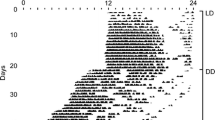Summary
Hamsters maintained in isolation boxes for 4–7 weeks were allowed to select their own lighting regimens by pressing levers, and to be active in running wheels. Three hamsters expressed circadian rhythms of light preference and of wheel-running activity (Figs. 1–3). Light tended to be selected during the inactive phase, and darkness was selected during wheel-running activity. By such a circadian rhythm of self-selected lighting, these hamsters are behaving in a way which may maintain those metabolic cycles that depend upon a 24-hour oscillation of light and darkness.
Similar content being viewed by others
References
Aschoff, J., v. Saint Paul, U., Wever, R.: Circadiane Periodik von Finkenvögeln unter dem Einfluß eines selbstgewählten Licht-Dunkel-Wechsels. Z. vergl. Physiol.58, 304–321 (1968)
Axelrod, J., Wurtman, R., Snyder, S.: Control of hydroxyindole 0-methyl-transferase activity in the rat pineal gland by environmental lighting. J. biol. Chem.240, 949–954 (1965)
DeCoursey, F.: Function of a light response rhythm in hamsters. J. cell. comp. Physiol.63, 189–196 (1964)
Hanson, L.: Unpublished doctoral dissertation, Columbia University, 1951. Cited in R. Lockard: Some effects of light upon the behavior of rodents. Psychol. Bull.60, 509–529 (1963)
Heppner, F., Farner, D.: Periodicity in self-selection of photoperiod. In: Biochronometry, p. 463–479. Washington, D. C.: National Academy of Sciences. (1971)
Kavanau, J.: Behavior of captive white-footed mice. Science155, 1623–1639 (1967)
Lockard, R.: Some effects of light upon the behavior of rodents. Psychol. Bull.60, 509–529 (1963)
Thor, D.: Circadian periodicity in self-stimulation with light: effect of previous light exposure. Acta psychol. (Amst.)32, 186–191 (1970)
Thor, D., Hoats, D.: A circadian variable in self-exposure to light by the rat. Psychon. Sci.12, 1–2 (1968)
Wahlström, G.: Self-selection of light and darkness in the canary and the effects of some drugs. Acta physiol. scand.50, Suppl. 175, 150–151 (1960)
Wahlström, G.: The circadian rhythm of the canary studied by self-selection of light and darkness. Acta Soc. Med. Upsalien.69, 241–271 (1964)
Yellin, A., Hauty, G.: Activity cycles of the rhesus monkey under several experimental conditions, both in isolation and in a group situation. J. Interdis. Cycle Res.2, 475–490 (1971)
Zuromski, E., Donovick, P., Burright, R.: Bar pressing for illumination change in albino rats with septal lesions. J. comp. physiol. Psychol.78, 83–90 (1972)
Author information
Authors and Affiliations
Additional information
This research was supported by a NDEA predoctoral fellowship to AWW, and USPHS Research Grant HD-04048 to BDS.
Rights and permissions
About this article
Cite this article
Warden, A.W., Sachs, B.D. Circadian rhythms of self-selected lighting in hamsters. J. Comp. Physiol. 91, 127–134 (1974). https://doi.org/10.1007/BF00694268
Received:
Issue Date:
DOI: https://doi.org/10.1007/BF00694268




